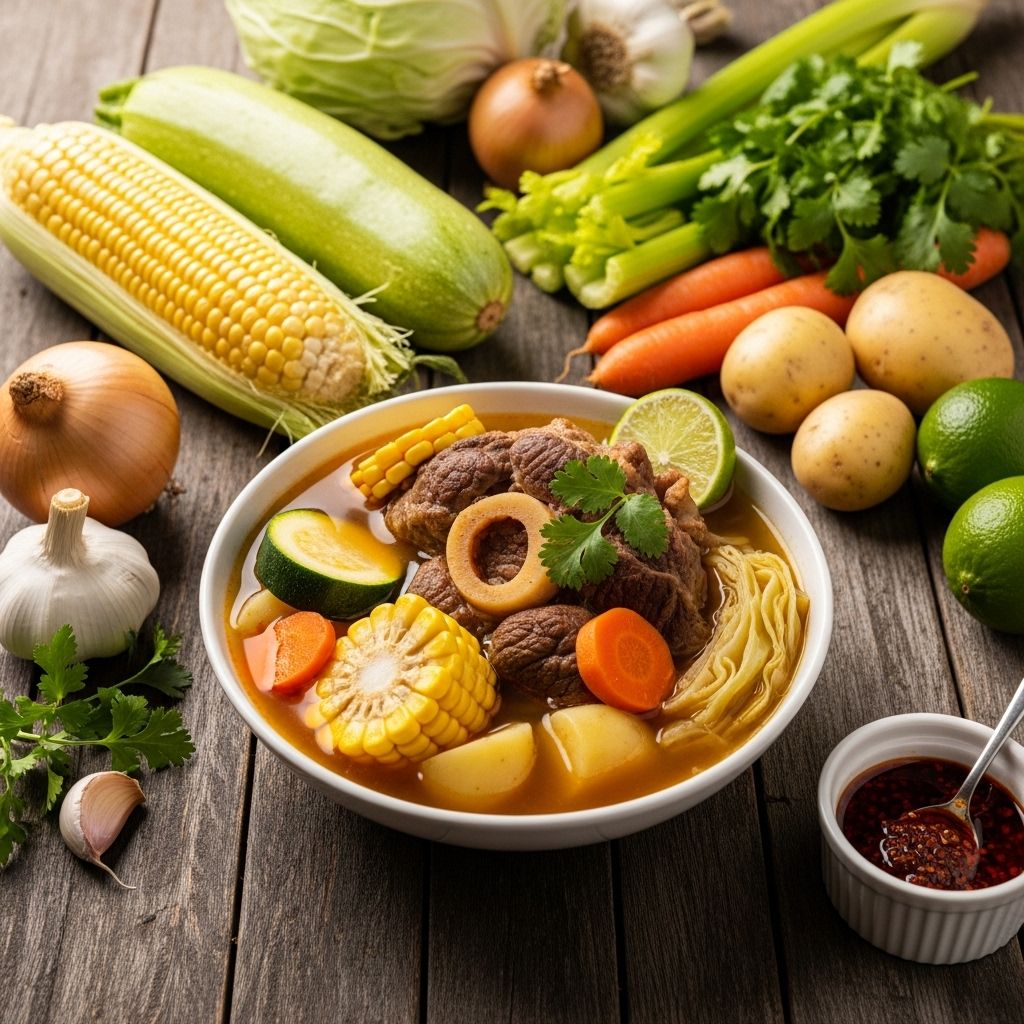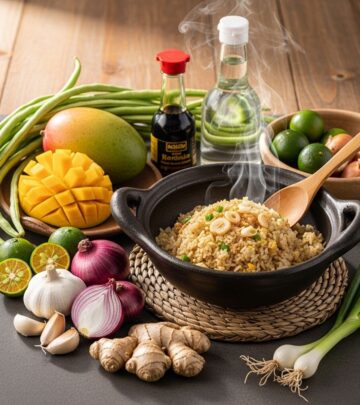Caldo De Res Recipe: 7 Steps To Authentic Mexican Beef Soup
Discover the hearty warmth of Caldo de Res, a classic Mexican beef soup rich with vegetables and comforting flavors.

Image: HearthJunction Design Team
Caldo de Res: The Traditional Mexican Beef Soup Experience
Caldo de Res, a staple of Mexican home cooking, is beloved for its flavorful broth, tender beef, and an array of nourishing vegetables. It’s a dish that brings comfort, warmth, and a sense of togetherness to any table—ideal for chilly days or as a hearty meal enjoyed with family.
What Is Caldo De Res?
Caldo de Res is a traditional Mexican beef soup loaded with vegetables and simmered to perfection. At its heart are bone-in beef shanks, which lend deep, meaty richness to the broth. Every bowl is brimming with chunky vegetables—think potatoes, corn, carrots, cabbage, and often a touch of chayote or zucchini—making it as filling as it is flavorful.
This dish is not only about taste; it’s also about the cherished experience of sharing a communal meal. Caldo de Res is typically served in generous portions, inviting diners to enjoy both the hearty solids and the rich, aromatic broth.
Ingredients for Caldo De Res
The beauty of Caldo de Res lies in its versatility and the freshness of its ingredients. The following list captures the essentials found in traditional recipes:
- Bone-in beef shanks – These form the backbone of the soup, imparting both flavor and nutrition.
- Vegetable oil – Used for browning the meat, enhancing the savory depth.
- Salt and black pepper – For seasoning the meat and broth.
- White onion – Both as a flavor base and garnish.
- Beef broth – Intensifies the soup’s beefy flavor.
- Diced tomatoes or stewed tomatoes – Bring a touch of acidity and color to the broth.
- Water – Helps achieve the soup’s characteristic light, clear broth.
- Carrots – Sliced into thick pieces for sweetness and texture.
- Cilantro – Adds freshness; both mixed in and as garnish.
- Chayotes (or zucchini/yellow squash) – Tender and mild, they soak up the broth’s flavors.
- Corn on the cob – Cut into rounds for rustic charm and bursts of sweetness.
- Potatoes – Usually left unpeeled and chopped into hearty chunks.
- Cabbage – Usually added near the end to preserve texture.
To garnish: Fresh cilantro, pickled jalapeños, finely chopped onions, lime wedges, and quartered radishes add brightness and zest to the finished bowl.
Step-by-Step: How to Make Caldo De Res
While each family may have its cherished nuances, the general process for making Caldo de Res follows a time-honored pattern. Here’s a comprehensive guide:
- Prepare the Beef: Cut the meat from the shank bones, leaving some meat attached for added flavor. Cube the separated meat.
- Brown the Meat: In a large stockpot, heat vegetable oil over medium-high. Season the beef pieces and bones with salt and pepper, then brown them until rich and caramelized on all sides.
- Sauté the Onion & Start the Broth: Add chopped onion to the pot, cooking until it softens and becomes fragrant. Stir in beef broth and diced or stewed tomatoes. Simmer gently until the meat begins to tenderize, typically for about 45 minutes to 1 hour.
- Build the Soup Base: Pour in additional water, bring back to a gentle simmer, and add carrots and cilantro. Let these cook until they begin to soften, infusing the broth with their flavors.
- Add Remaining Vegetables: Introduce the chayotes (or squash), corn rounds, potatoes, and cabbage. Continue simmering until all vegetables are tender but not mushy, usually 30–40 minutes.
- Final Touches: Taste and adjust seasoning, adding more salt or pepper if needed. Skim off any excess fat or foam from the surface to clarify the broth.
- Serve: Ladle the soup into large bowls, ensuring each serving gets a mix of beef, bone, and all the vegetables. Dress with fresh garnishes just before eating.
Traditional and Optional Garnishes
Garnishes play a vital role in customizing each bowl to personal taste. Here are the most popular Caldo de Res toppings:
- Lime wedges – squeeze over the soup for a citrusy lift.
- Chopped cilantro – enhances freshness and aroma.
- Pickled jalapeños – for tang and gentle heat.
- Finely diced onion – adds a crunchy bite.
- Quartered radishes – deliver a peppery crunch.
- Corn tortillas (warm or toasted) – perfect for sopping up broth or piling with beef and veggies.
Tips for the Perfect Caldo De Res
- Keep the Bones: Simmering beef shanks with bones is essential—marrow and connective tissue enrich the broth with body and flavor.
- Skim the Broth: During the initial simmer, regularly skim off foam and excess fat for a clear, clean-tasting soup.
- Add Vegetables Gradually: Start with root vegetables like carrots and potatoes, then add quicker-cooking items like chayote, squash, and cabbage closer to the end to prevent overcooking.
- Customize Your Mix: Feel free to swap or add vegetables based on seasonality and preference—zucchini, yellow squash, and even green beans are welcome additions.
- Don’t Rush: The simmering time is key for developing depth of flavor and meltingly tender meat.
Serving Suggestions
Caldo de Res is best served piping hot, ideally straight from the pot. Traditionally, the broth and solid ingredients are ladled together into deep bowls. Here are some classic accompaniments:
- Fresh, warm corn tortillas for dunking or wrapping tender chunks of beef and vegetables.
- A side of steamed white rice, sometimes added directly to the bowl.
- Pickled vegetables or salsa for contrasting acidity and heat.
Storage and Leftovers
Caldo de Res keeps well and often tastes even better the next day as flavors continue to meld. Here’s how to store and reheat it properly:
- Refrigerator: Store cooled soup in an airtight container for up to 3–4 days.
- Freezer: For longer storage, freeze in sealed containers for up to 2 months. Be sure to cool the soup completely before freezing. Allow some room in the container for expansion.
- Reheating: Gently reheat on the stovetop over medium-low heat. Add a splash of water or broth to adjust consistency if needed.
Variations: Regional and Personal Twists
The soul of Caldo de Res lies in its adaptability. While the basic structure remains the same, every cook brings their own flair. Some common variations include:
- Instant Pot or Pressure Cooker Caldo de Res: Reduces cooking time dramatically while preserving deep flavors and tender textures.
- Different Vegetables: Regional or seasonal variations may include green beans, squash blossoms, chiles, or turnips.
- Tomato Sauce: Some cooks stir in a bit of tomato sauce for a richer, slightly thicker broth.
- Rice: White rice can be added to the broth toward the end of simmering or served alongside.
- Herbal Variations: While cilantro is standard, a bay leaf or sprigs of fresh oregano can also be added to the broth for extra aroma.
Nutrition Profile
Caldo de Res is naturally wholesome, featuring lean beef, fresh vegetables, and a clear, protein-rich broth. The nutritional profile can vary based on ingredients, but a typical serving is:
| Nutrient | Approximate Amount (per bowl) |
|---|---|
| Calories | 320–450 |
| Protein | 25–35g |
| Fat | 10–18g |
| Carbohydrates | 25–35g |
| Fiber | 5–8g |
| Sodium | Varies by broth and seasoning |
Note: Nutrition will be impacted by the cut of beef and quantity of garnishes used.
Why Caldo De Res Is So Beloved
This humble soup is more than the sum of its parts. Caldo de Res delivers:
- Comfort: The warmth of the broth and heartiness of the ingredients make it a classic comfort food.
- Nutrition: Loaded with vegetables, protein, and essential vitamins.
- Tradition: A dish prepared and shared through generations—synonymous with family, celebration, and togetherness.
- Versatility: Easy to modify according to dietary needs or available produce.
Frequently Asked Questions (FAQs)
Q: Can I make Caldo de Res in advance?
A: Absolutely! In fact, the flavors deepen and improve if the soup is made a day ahead. Store in the refrigerator and gently reheat before serving.
Q: Can I use a different cut of beef?
A: While bone-in shank is traditional, other stewing cuts (like chuck or brisket) can be used. However, the bones contribute unique richness, so try to include at least a few for the best result.
Q: What if I can’t find chayote?
A: Zucchini or yellow squash are great substitutes and provide similar mild flavors and textures.
Q: Is Caldo de Res spicy?
A: The basic soup is not spicy. Spice is typically added via pickled jalapeños, salsa, or hot sauce at the table, allowing each person to adjust their heat level.
Q: Can I make it vegetarian?
A: For a vegetarian version, omit beef and use a rich vegetable broth. Add mushrooms or plant-based protein for extra heartiness.
Conclusion
Caldo de Res stands as a testament to the soul of Mexican home cooking: simple, nourishing, and deeply flavorful. Whether enjoyed as a comforting meal on a chilly night or as the centerpiece of a family gathering, this classic beef and vegetable soup brings people together around the table. With its rich broth, tender meat, and vibrant vegetables, every spoonful is a taste of tradition—one worth savoring and sharing for generations to come.
References
- https://www.allrecipes.com/recipe/85055/caldo-de-res-mexican-beef-soup/
- https://www.allrecipes.com/recipe/15273/caldo-de-res-beef-soup/
- https://www.allrecipes.com/recipe/276697/gringa-caldo-de-res-for-the-instant-pot/
- https://www.food.com/recipe/caldo-de-res-a-mexican-beef-vegetable-soup-223546
- https://dashofcolorandspice.com/caldo-de-res-mexican-beef-soup/
Read full bio of Anjali Sayee












